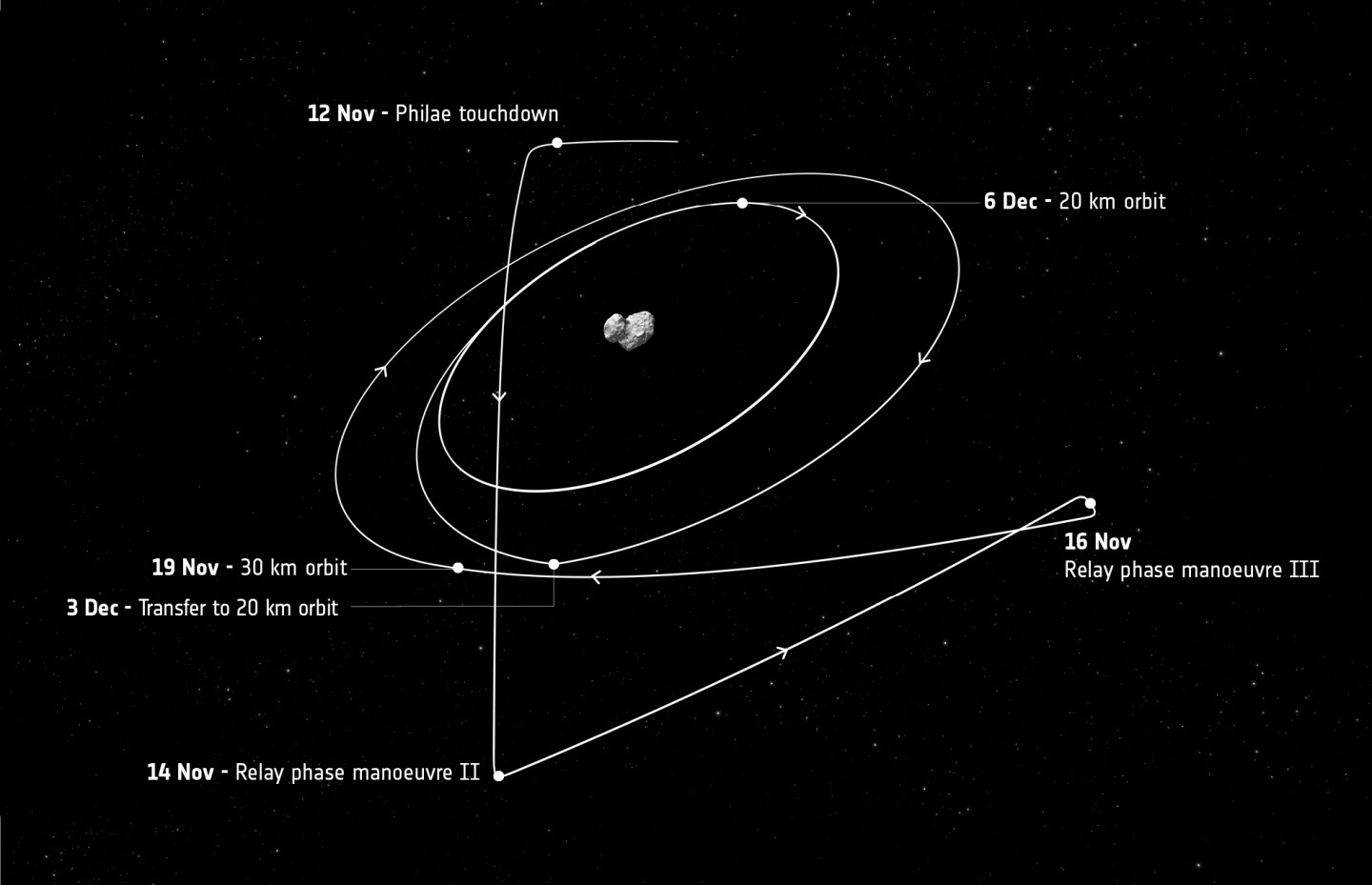As Philae begins its long sleep, bedded down on the surface of comet 67P/Churymov–Gerasimenko (67P), mankind's attention shifts back to the Rosetta spacecraft as she begins the next phase of her mission. Over the course of the next year, Rosetta will become the first spacecraft to orbit and observe a comet as it approaches the Sun, allowing the already successful mission to detail the evolving characteristics of 67P as the heat from our star causes a dramatic rise in activity.
Since arriving at 67P on Aug. 6, Rosetta's orbit around the comet has been dictated by the necessity of positioning Philae for an ideal descent trajectory. With this arduous phase completed, the spacecraft's orbit will be decided on the basis of the optimum range of the scientific equipment being employed at the time.
"With lander delivery complete, Rosetta will resume routine science observations and we will transition to the ‘comet escort phase'," states Flight Director Andrea Accomazzo. "This science-gathering phase will take us into next year as we go with the comet towards the Sun, passing perihelion, or closest approach, on 13 August, at 186 million kilometers from our star."
Comet activity is expected to rise exponentially as 67P approaches the Sun, and so mission operators will have to prioritize the instruments that require a lower orbit to achieve maximum scientific output first. As heat from the Sun thaws gasses trapped inside the comet, the situation become more hazardous, forcing the spacecraft into a safer, more distant orbit.
These gasses and the dust particles they carry with them form what is known as the comet's coma – a cloud of gas and dust that surrounds a comet, with a tail that often trails millions of kilometers into space. Whilst the coma is one of the primary characteristics of the comet on which the mission hopes to gain an insight, the outflow of material created by the phenomenon also poses a risk to the spacecraft. At its worst, the destabilizing effects of the coma have the capacity to throw Rosetta's orbit off, potentially compromising the continued success of the mission.

The Rosetta comet-chasing mission is by its nature one of firsts, and as such, mission operators have little to no knowledge of how quickly or how intensely the activity on 67P will progress. To counter this uncertainty, each stage of the escort phase of Rosetta's mission has been designed with a "preferred" trajectory and a "high-activity" trajectory. The option of a higher orbit will allow Rosetta to safely continue to observe the comet (albeit in a reduced capacity) even if activity from the coma exceeds expected levels.
Beginning Dec. 3, the spacecraft will begin a series of maneuvers to take her to within 20 km (12 miles) of 67P, during which time Rosetta will map the nucleus of the comet using the orbiter's high-resolution cameras, while collecting gas, dust and plasma for analysis. Rosetta will remain in this orbit for 10 days before retreating to a safer orbital range of 30 km (19 miles).
Last week, Philae, Rosetta's companion for the duration of the decade-long voyage to rendezvous with the comet, fell victim to the unpredictability of the mission, coming to rest in the shadow of a cliff that prevented the lander's solar panels from receiving sufficient sunlight. This caused Philae's batteries to drain, forcing her into a deep sleep only 64 hours after its mission began.
However, there may yet be hope for the robotic pioneer. As 67P moves ever closer to the Sun, the level of illumination at the site where the lander came to rest may gradually increase to the point where the lander's solar panels can gather enough light to wake Philae from its hibernation. Therefore, early next year Rosetta will be switched to a special mode that will allow it to listen for a tell-tale signal from the surface of 67P, the receipt of which would let us know that Philae has woken from its long rest.
Whilst some may believe that the exciting part of the Rosetta saga has come to an end, with all 11 instruments functioning perfectly on an orbiter riding a comet toward the Sun, there may be some headlines left yet.
Source: ESA





